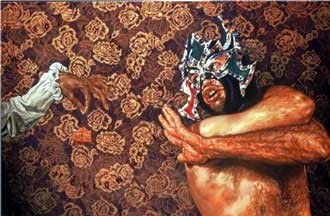A spirit of resistance is alive and well in Bihl Haus’ stones
The ghost of the Alamo hangs heavy over San Antonio, its continually revised history a bellwether for the shifting demographics and sensibilities of the city. Olvídate del Alamo, Forget the Alamo, is the rousing name of an annual exhibit, held this year in the newly renovated Bihl Haus Arts space on Fredericksburg Road, that tries to confront the one-sided legacy preserved for so long in Texas and American history books. The name is ironic, of course, because we can’t forget the shrine to (pick one) Texas’ fallen heroes who gave their life for the future state, or Mexican General Santa Anna’s last successful attempt to retain the territory for post-colonial Mexico.
| A Primrose resident relaxes outside the restored Bihl Haus. |
But we can have some fun with it, and the most successful pieces in the show have a sense of humor. Portraitist Angel Rodriguez-Diaz displays his self-portrait, “Forget the Alamo,” which shows the masked artist warding off an Alamo ornament. If you missed his one-man show last year at the Southwest School of Art & Craft, you can take Cliffs Notes on his richly layered symbolism by checking out this painting and the one on display in the San Antonio Museum of Art’s Retratos exhibit.
A series of detailed images of the Alamo in various states of pre-shrine decrepitude line the remaining walls, punctuated by the occasional folk-art-style painting, a few of the former by Ramón Vasquez y Sánchez. To me they exhale the suffocating warm breath of history books and church, but at the February 23 opening, I overheard a man enthusiastically explaining to his date how the gringos who built the shrine changed the original structure — doing away with an inconvenient second floor, for instance — to make a better postage-stamp image.
| Inside the building, a self-portrait by Angel Rodriguez-Diaz. |
Across the room from Rodriguez-Diaz’ painting, a video by Rolando Briseño and Jorge Sandoval provides comic relief from the historical-accuracy debate around it. Enthusiastic participants take turns swinging at a giant Alamo piñata; when it finally breaks open, tiny, plastic, brown babies fall to the ground. The video appears to have been filmed in the gallery, which adds another layer to the joke: You are watching the digital reenactment of a momentous event as you stand in the sacred place where it happened. Sandoval giggled with glee as we watched the stick swingers pick up the little dolls and wave their bottles at the camera, proof that sometimes laughter is the best revenge.
But if counting stones in old images turns you on, after perusing Vasquez y Sánchez’ work, you might begin to wonder what happened to the pieces of the Alamo that didn’t make it into the tourist attraction. Like Davy Crockett and the storied Defenders, you are surrounded. The walls of Bihl Haus are said to be made of salvaged Alamo stones that went through one or two previous incarnations before they were made into a modest Italianate home in what became the historic Monticello District.
| A watercolor by Ramón Vasquez y Sánchez. |
More recently, the building was familiar to residents of the neighborhood as a romantic-looking ruin in an empty field, graffiti and evidence of fires visible from Fredericksburg Road.
“You remember the property; it was a danger and it was an eyesore,” says Director Kellen Kee McIntyre, who lives in the neighborhood with her husband, Eric Lane. “Kids were hanging out and trying to burn the place down and doing drugs, and cops were through here all the time.” But now, thanks to the efforts of McIntyre and other members of the Monticello Park Neighborhood Association, which lies within District 7, Bihl Haus is beautifully restored as a community art center, with period pine floors, an oak ceiling, a wheelchair-accessible restroom, and a rebuilt fireplace. The restoration was provided courtesy of Southwest Housing, which built and operates the Primrose Senior Retirement Apartments that encompasses Bihl Haus. Southwest invested in the property after the neighborhood association waged a successful two-year fight to keep out a KB Homes development. “`Southwest Housing` came in the door and the first thing they did was say, all right, what does the neighborhood want?” recalls McIntyre. “Which was the last thing KB Homes did.”
| OlvÍdate del Alamo 1-4pm Fri-Sat, & by appt. Through Mar 6 Closing reception & poetry reading: 7pm Mar 6 Free Bihl Haus Arts 2803 Fredericksburg 829-3855 or 432-1896 |
Two things the neighborhood asked for were the preservation of Bihl Haus and a community art center, which is now scheduled with shows through next December. The board consists of McIntyre, Eric, and Rita Maria Contreras, who review proposals; the only criteria for application is that one of the artists either live or work within a three-mile (soon to be five-mile) radius of the center. “It’s very much about the community,” says McIntyre, who has found three Primrose residents to serve as docents during gallery hours.
At the Thursday opening, the crowd was enthusiastic but thin because a contingent of artists who had gone to speak to City Council in support of beleaguered District 7 Councilwoman Elena Guajardo had not yet returned. But their reclaimed Alamo awaited them. •
By Elaine Wolff




